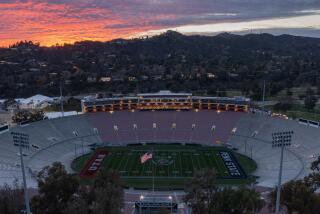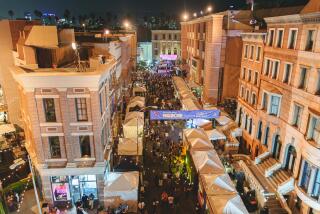As Rose Bowl approaches, players are digging in â for some prime rib
At some point after Ed Muransky had consumed three or four slabs of prime rib, along with vegetables and Yorkshire pudding, a waitress mentioned that he was halfway to the record.
An offensive lineman of suitable proportions -- 6 feet 7 and 280 pounds -- Muransky had room for more. He glanced across the table at his pal, Bubba Paris.
âWe should try for it,â he said.
It was December 1978 and the Michigan football team had gone to Lawryâs the Prime Rib in Beverly Hills for the âBeef Bowl,â an annual dinner for players competing in the Rose Bowl game.
This meal has become a Southern California tradition, a holiday staple not unlike the Hollywood Christmas Parade or the lighted boats off Newport Beach.
The numbers are mind-boggling, if not artery-clogging: Lawryâs claims to have served more than 75,000 pounds of Midwestern corn-fed beef to about 19,000 players and coaches over the last five decades.
âThereâs pressure on everybody getting ready for the game,â said John Robinson, a former USC coach. âThe Beef Bowl is one of the things you can really enjoy.â
Muransky -- who resembled an oversized version of Wally Cleaver back then -- got swept up in the moment. The freshman did not figure to play much in the game, so he wanted to leave his mark another way.
The waitress brought a fifth cut, then a sixth. Paris soon dropped out but Muransky persevered and word circulated around the dining room.
âI was 18 and I didnât know any better,â Muransky recalled. âI got to seven and needed just one more for the record.â
Just one more piece to stamp his name on the peculiar history of the Beef Bowl.
The 55th annual Beef Bowl commenced Monday evening when the Texas Christian team and its boosters -- the competitors always dine on separate days -- pulled up to the restaurant in five buses.
They entered by way of a red carpet to a dining room of dark wood and booths and tables with crisp linens. Waitresses stood ready in aprons and starched hats; carvers donned white gloves to check on roasts kept warm in gleaming stainless-steel carts.
Rumor spread among the players that there might be some type of competition, so center James Fry devised a strategy.
âCut it in big chunks,â he said, âand have an open mouth.â
A low rumble arose when the food arrived, scores of large athletes digging in and mumbling their approval.
Seated at the head table was Richard N. Frank, the man who started the whole thing. Frank attended his first Rose Bowl game in 1930 or â31, and while he cannot recall the details, it must have been impressive.
âIâve missed only three since then,â he said.
His father, who co-owned Van de Kampâs bakery, opened the first Lawryâs in 1938. As soon as Frank took charge of the restaurant, in the mid-1950s, he sought to create a tie with his favorite college football game.
Tournament of Roses officials liked the idea of a fancy dinner, as did the Pacific 10 Conference, known as the Pacific Coast Conference then. The Big Ten, which has sent its champion to meet the Pac-10 champ in the Rose Bowl for most of the last 60 years, was not entirely convinced.
âA couple of coaches didnât want to come to the restaurant,â Frank said. âThey saw it as too much of a distraction.â
A compromise led to the first Beef Bowl in 1956 -- Lawryâs trucked its food and carvers, not to mention those massive carts, to the Big Ten practice field. A photograph shows Iowa players fresh from drills, wearing T-shirts and shorts, receiving their plates from servers in tall, white hats. They ate at tables beside the grandstands.
But this arrangement proved cumbersome -- âDo you know how much those carts weigh?â Frank asked -- and in the 1960s, the Big Ten coaches agreed to make the trip to Beverly Hills.
Well, most of them did.
Robinson attended his first Beef Bowl not as a coach but as a player, a senior end for Oregon at the 1958 Rose Bowl. Like many college athletes over the years, he recalls being starry-eyed.
âIâd only had prime rib once or twice in my life,â he said. âIt was just a different level than youâre used to.â
So it made sense that, as a USC coach from the 1970s through the â90s, he brought his teams back every time they won the conference championship. In preparing for bowl games, he followed the lead of his former boss John McKay who, he recalls, âwas big on letting the kids have fun.â
Not everyone believed in that policy.
Several Big Ten coaches, in particular, continued to view the events surrounding the game -- news conferences, a luncheon, an afternoon at Disneyland -- as disruptions.
The legendary Woody Hayes allowed his Ohio State team to eat prime rib before the 1958 game -- on the practice field -- but declined subsequent invitations to the restaurant. Former Iowa coach Hayden Fry brought his team to the Beef Bowl before the 1982 game and complained, âMy guys probably gained 10 pounds each.â
The Hawkeyes skipped the meal four years later. Fry snapped: âI donât think Lawryâs beef is as good as Iowa beef anyway.â
Frank wrote him a letter soon after, asking that he reconsider the next time his team qualified for the Rose Bowl. The Hawkeyes accepted the invitation before the 1991 game and lost to Washington, 46-34, a few days later.
Not too long after the inaugural Beef Bowl, a public relations firm hired by the restaurant suggested an eating contest. Though no one weighs each slice -- the cuts average 12 ounces -- Lawryâs began reporting estimates for total pounds consumed by each team.
The idea was a hit with players and the media, growing even more popular in the last decade or so.
In 1997, Washington State lineman Ryan Tujague ate so much that he reported feeling dizzy. Five years later, Oklahomaâs Brett Rayl told the Associated Press that after pushing himself from the table, âI went back to my room and threw up.â
The teams with the biggest appetites have won 70% of the Rose Bowl games. Even the reticent Big Ten schools have racked up monstrous numbers -- Purdue set an unofficial team record of 734 pounds before the 2001 game.
By then, Lawryâs had grown a little uncomfortable with the notion of fine dining as a competition and had attempted to turn down the volume on the three-hour affair, briefly changing its name to the âBeef Scrimmage.â That failed, so the restaurant instituted a two-serving limit.
Still, when the Texas Longhorns arrived before the 2005 game, Coach Mack Brown announced to his team: âBoys, donât forget, we have a contest going here.â
Players desiring extra meat now operate under the radar, procuring food from teammates who do not want their second helpings. Word often gets around and television news crews gravitate toward the ravenous partyâs booth.
Frank wishes everyone would forget about gross consumption.
âWe donât want people to think of our restaurant,â he said, âas a place where you pile the food on.â
This seasonâs other Rose Bowl team -- Wisconsin -- had its turn at the Beef Bowl on Tuesday evening.
The Badgers got the same red-carpet treatment with their fight song blasting from speakers out front and waitresses making a show of pouring dressing from high above spinning bowls of salad.
The final tally showed TCU defeating Wisconsin by 670 pounds to 650, and there was no report of any player matching Muranksyâs performance from that night three decades ago.
His bid to surpass the record of seven pieces had nearly derailed at the last moment when he attracted an unwanted spectator: His coach, Bo Schembechler.
âBo was not happy,â Muransky said.
The player moved quickly, diving into No. 8 before Schembechler could intervene.
The next morning, he was punished with extra plays and extra sprints, running until he was sick. But he has no regrets. The lineman, who later made All-American and played for the Los Angeles Raiders, takes unabashed pride in a record that, despite numerous attempts, still stands.
âThese are the types of traditions that make bowl games fun,â he said. âYou hold onto things like that.â
Michigan returned to the Rose Bowl in 1981, affording him another visit to Lawryâs. He and Paris were starters by then, and Schembechler took no chances.
When the team arrived for dinner, Muransky recalls, the linemen were seated at the coachâs table.
twitter.com/LATimesWharton



